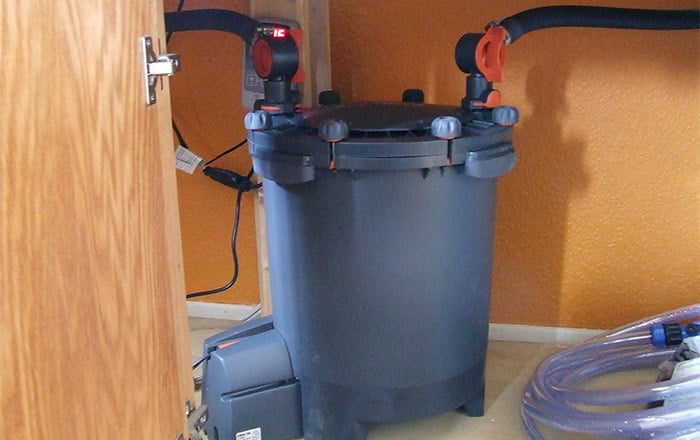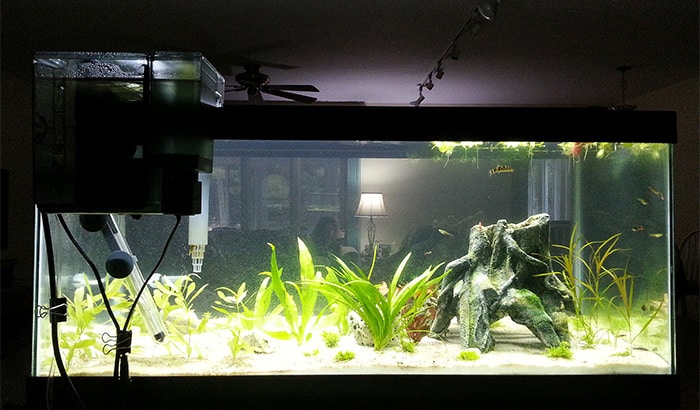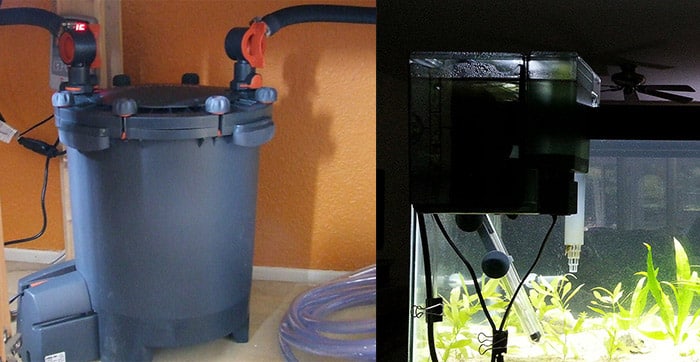Are you looking for a new aquarium filter? There are many different types to choose from, including canister filters and hang-on-back (HOB) filters. Both types have advantages and disadvantages, so it can be difficult to decide which is right for you.
Read on below to see their functions and benefits, as one of them might suit your current requirements better.
Things to know about Canister Filter and HOB Filter

1. Principle of Operation
Canister filters are gravity fed.
- Water is taken from the aquarium via an inlet tube and pushed through the filter media by a pump.
- The water then returns to the aquarium via an outlet tube.
- Some canister filters have a built-in UV sterilizer.
Hang on back filters are also gravity fed.
- It draws water from the aquarium via an inlet tube and passes through the filter media.
- Then, water returns to the aquarium via an outlet tube or overflows back into the aquarium.
2. Water loss
Hang-on-back filters have proven to be more efficient in terms of water loss compared to canister filters.
Canisters are prone to leaks and will result in frequent refilling, while HOB filters tend not to leak as much.
Additionally, canister filters typically require you to pour the water manually, which can be a hassle if you’re trying to manage multiple types of fish or aquatic plants at once.
With a hang-on-back filter, all you need to do is attach it directly to your tank and turn it on. The process takes just minutes without any manual labor involved.
3. Water Paraments
Canister filters are better at handling a higher volume of water.
- They can cycle through the entire tank more quickly than a hang-on-back filter.
- This means that they are better at keeping the water quality high and removing toxins and other impurities from the water.
- Canister filters also have more room for media, so you can add more filtration media to them to help keep the water even cleaner.
- Hang-on-back filters typically only have room for one or two types of media, so they are not as effective at filtering the water.
4. Cost
Canister filters are typically more expensive than hang-on-back filters. This is because they are larger and have more features than hang-on-back filters.
However, they will last longer and better filter the water, so they are worth the extra cost.
Hang-on-back filters are usually cheaper than canister filters, making them a more affordable option for budget-conscious aquarists.
5. Ease of Use and maintenance
Canister filters can be more challenging to set up and maintain than hang-on-back filters. You have to clean them more often. They have a larger surface area that needs regular cleaning and changing media cartridges.
They have more parts that can break or need to be replaced. However, once you get the hang of using a canister filter, they are not difficult to use. Hang-on-back filters are much easier to set up and maintain than canister filters.

Canister Filter vs Hang on Back Filter: Which one is Better?

Overall, both canister and hang-on-back filters have pros and cons, and the choice between them will depend on your individual needs and preferences.
Both canister filters and HOB filters are suitable for a wide range of aquarium types and water conditions.
Some potential benefits of a canister filter include its high capacity for filtration media, ease of cleaning and maintenance, and relatively low cost compared to other types of filters.
On the other hand, some possible advantages of HOB filters include their easy installation, affordability, and generally quieter operation than canister filters.
- A canister filter connects to an inlet hose that draws water from the tank, pushing it through the filter media and back into the tank via an outlet hose.
- A HOB filter is designed to be mounted on the side or back of an aquarium. It has an inlet tube that draws water from the tank and flows through the media.
A canister filter may be the best option if you need a powerful and easy-to-hide filter. But if you want a simple, inexpensive solution with less maintenance, then a HOB filter may be the better choice.
In terms of efficiency and performance, canister filters tend to be more powerful than HOB filters. They use large amounts of water flow to effectively remove debris and waste from the tank, making them ideal for larger tanks or heavily stocksetu sups.
On the other hand, HOB filters are typically smaller and less expensive than canister filters, making them a good choice for smaller tanks or occasional hobbyists.
In terms of maintenance and ease of use, canister filters can be more difficult to clean than HOB filters.
Canister filters have several parts that need to be disassembled and cleaned on a regular basis, while HOB filters typically only require occasional cleaning of the filter media.
Sopurce: Prime Time Aquatics
Conclusion
Which Aquarium Filter is right for you – canister filter vs hang on back? If you are a beginner aquarist, we recommend starting with a hang on back filter. They are easier to install and maintain than canister filters, and they still provide great filtration for your tank.
However, if you have more experience with aquariums and want to take advantage of the extra space that canister filters offer, then go for it! Just be sure to research the different brands and models available so you can find one that fits your specific needs.




